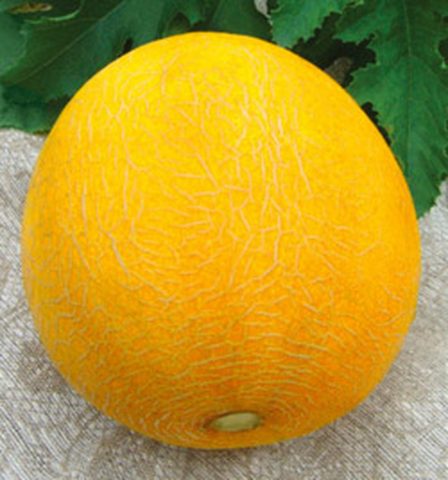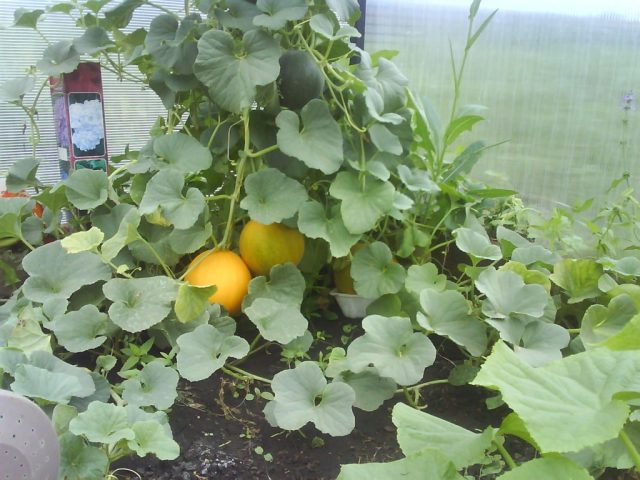Content
The cultivation of melons requires a special approach. First of all, you should choose the right variety. It can be early melon or mid-season, round or oblong in shape with different tastes. Melon Idyll is popular among gardeners and gardeners due to its many positive qualities.
Description of the Idyll melon variety
This variety was bred in the North Caucasus. The plant has heart-shaped leaves. Refers to medium-bushy plants. For half a century, it has managed to capture the hearts of most melon lovers. Melon fruits of this variety can weigh up to 5 kg. The color of ripe fruits is yellow with a solid mesh of white pattern. Melon Idyll is shown in the photo:
The pulp is white with a slight greenish tinge. The graininess of the fruit is pronounced. Melon seeds Idyll are yellow lanceolate. The plant contains flowers of both sexes. According to the ripening period, the melon belongs to the middle-late varieties. The entire cycle from seed to seed takes 80 days.
It tolerates a drop in temperature, but cannot grow normally without water.
Pros and cons of the variety
Each variety has its own advantages and disadvantages. Melon Idyll is suitable for wholesale buyers, as it has a high shelf life. In addition, the advantages of the Idyllia variety include:
- resistance to many diseases and pests;
- good indicators of transportability;
- high yield (up to 28 tons can be harvested per hectare);
- taste is also on top.
But there are also some disadvantages:
- does not tolerate drought, it is necessary to monitor watering;
- in the open field it grows only in the southern regions.
With full observance of all the nuances of agricultural technology, the Idyll melon ripens in September and pleases sweet lovers with its aroma.
Melon Cultivation Idyll
To get the maximum yield, it is necessary to plant the melon correctly, as well as observe all the nuances of its cultivation. First of all, it is important to choose the soil and the place where the future melon culture will grow.
Seedling preparation
Before planting a crop, you need to properly grow or choose seedlings. For cultivation, you need to pick up the strongest seeds and soak them first. Then the swollen seeds are placed in a nutritious soil or in a peat cup.
After two weeks, the seedlings are fed with complex mineral fertilizers. After the seedlings form 5 leaves, it is necessary to harden. This is a procedure in which the seedlings are taken out for 15 minutes in the open air, the time is gradually increased to 1 hour.
Selection and preparation of the landing site
The planting site should be sunny with no shade. Also, there should be no drafts in the selected area. Poor melon precursors are carrots and pumpkin.
Melon does not like clay soil, and therefore it is better to add river sand to such soil before planting. For 1 sq. m is enough for half a bucket of sand.
In the spring, when digging a site for planting for a melon, it is necessary to add potash and phosphorus fertilizers. Experts advise applying nitrogen fertilizers just before planting. Instead, rotted manure will do.
Landing rules
Melon can be planted not only in open ground, but also in a greenhouse. For greenhouse planting, the dates can be shifted a couple of weeks earlier. For the northern regions, the date for planting in a greenhouse is May 20.
It is necessary to plant the melon at such a distance that it can drift freely.The optimal time for planting seedlings of the Idyllia variety is mid-May. In the open field, the planting pattern for seedlings is 140 X 100 cm.In the greenhouse, 70 X 70 cm.
Watering and feeding
Particular attention should be paid to watering the Idyll. This variety is picky about soil moisture and may not yield a crop during drought. At the same time, it is not recommended to swamp the site so that the plant is not affected by powdery mildew. The best option would be to organize drip irrigation, as well as mulching seedlings to maintain sufficient moisture in the soil.
Particular attention must be paid to feeding. Nitrogen fertilizers are applied during flowering and pollination. Enough 20 g of fertilizer per 10 liters of liquid.
Potash fertilizers are suitable for the plant to withstand extreme heat. Also, with the timely application of potash fertilizers, the melon ripens faster.
Once a month, it is recommended to water the Idyll melon with a solution of ash.
Formation
If the plant grows in a greenhouse, then it must be tied to trellises. It is not necessary to do this outdoors. Formation begins when the fourth normal leaf appears on the bush. The stem is pinched above the fourth leaf, then on the lateral shoot that appears, pruning is also performed after the 5th leaf.
This is done for normal pollination. Only male flowers can be found on the main shoot. For the appearance of female flowers, the presence of lateral shoots should be ensured.
When grown outdoors, it is important to ensure that the leaves and shoots do not block the emerging fruits from the sun. It is necessary to put linoleum, a board under the fruit so that the fruit does not lie on the ground and does not start to rot.
Harvesting
Harvesting of the Idyll melon begins at the end of August. More precise terms depend on climatic conditions and the specific growing region, as well as on the method. Melon, unlike many fruits, does not ripen outside the bush, and therefore it cannot be picked and put to ripen. Harvesting is necessary only when the melon is fully ripe.
The ripeness of the melon can be determined by its characteristic color, white mesh, as well as the special aroma that only ripe fruits emit. When grown in a greenhouse on trellises, it is recommended to place the fruits in a net so that they do not break off and do not fall to the ground. The net is also tied to the trellis and removed together with the fruit, after full ripening.
Diseases and pests
Melon Idyll is considered resistant to most classic diseases and pests. But in case of violation of the rules of agricultural technology, planting, improper care, such diseases may occur:
- powdery mildew, false and real;
- anthracosis.
To avoid such pathologies, it is recommended to ensure correct, but not excessive watering, as well as remove all leaves that are suspected of infection.
For prevention, it is not recommended to plant a melon in areas where there were related plants, so that crops do not catch common diseases. At the first sign of powdery mildew, the plant should be treated with special preparations. They should be bred strictly according to the instructions.
Melon Idyll reviews
Conclusion
Melon Idyll is suitable for growing outdoors or in a greenhouse. Does not require special care, is not susceptible to most diseases. It is important to feed the bush and shape it correctly so that the plant has both male and female flowers. Then pollination will be successful and the harvest will be sufficient. Optimal soils are light soils with high organic values.











